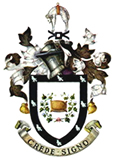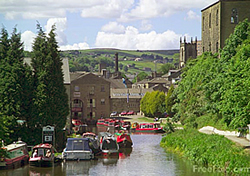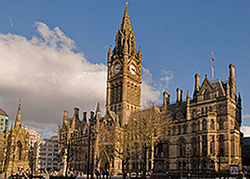 Rochdale is a large market town in Greater Manchester, England. It lies amongst the foothills of the Pennines on the River Roch, 5.3 miles (8.5 km) north-northwest of Oldham, and 9.8 miles (15.8 km) north-northeast of the city of Manchester. Rochdale is surrounded by several smaller settlements which together form the Metropolitan Borough of Rochdale, of which Rochdale is the largest settlement and administrative centre. Rochdale has a total population of 200,000.
Rochdale is a large market town in Greater Manchester, England. It lies amongst the foothills of the Pennines on the River Roch, 5.3 miles (8.5 km) north-northwest of Oldham, and 9.8 miles (15.8 km) north-northeast of the city of Manchester. Rochdale is surrounded by several smaller settlements which together form the Metropolitan Borough of Rochdale, of which Rochdale is the largest settlement and administrative centre. Rochdale has a total population of 200,000.
Rochdale seems to be named from its position on the River Roch but is recorded as Recedham in the Domesday Book. The name is derived from from Old English reced meaming "hall", and ham, a "homestead". Over time, the name changed to Rachedale and eventually Rochdale. The river's name is a back-formation from the Old English name
The ancient parish of Rochdale was a division of the hundred of Salford and one of the largest ecclesiastical parishes in England comprising several townships. Rochdale flourished into a centre of northern England's woollen trade, and by the early 18th century was described as being "remarkable for many wealthy merchants".
 Rochdale rose to prominence during the 19th century as a major mill town and centre for textile manufacture during the Industrial Revolution. It was a boomtown of the Industrial Revolution, and amongst the first ever industrialised towns. The Rochdale Canal, one of the major navigable broad canals of the United Kingdom, was a highway of commerce during this time used for the haulage of cotton, wool, coal to and from the area.
Rochdale rose to prominence during the 19th century as a major mill town and centre for textile manufacture during the Industrial Revolution. It was a boomtown of the Industrial Revolution, and amongst the first ever industrialised towns. The Rochdale Canal, one of the major navigable broad canals of the United Kingdom, was a highway of commerce during this time used for the haulage of cotton, wool, coal to and from the area.
The socioeconomic change brought by the success of Rochdale's textile industry in the 19th century led to its rise to borough status and it remained a dominant settlement in its region. However, during the 20th century Rochdale's spinning capacity declined towards an eventual halt.
Rochdale today is a predominantly residential town.
Rochdale is the birthplace of the Co-operative Movement. The Rochdale Equitable Pioneers Society, founded in 1844, was the first modern cooperative
 Rochdale Town Hall is a Victorian-era municipal building "widely recognised as being one of the finest municipal buildings in the country". The Grade I listed building is the ceremonial headquarters of Rochdale Metropolitan Borough Council and houses local government departments, including the borough's civil registration office. Built in the Gothic Revival style it was inaugurated on 27 September 1871.
Rochdale Town Hall is a Victorian-era municipal building "widely recognised as being one of the finest municipal buildings in the country". The Grade I listed building is the ceremonial headquarters of Rochdale Metropolitan Borough Council and houses local government departments, including the borough's civil registration office. Built in the Gothic Revival style it was inaugurated on 27 September 1871.
The architect, William Henry Crossland, won a competition held in 1864. The town hall had a 240-foot (73 m) clock tower topped by a wooden spire with a gilded statue of Saint George and the Dragon which were destroyed by fire on 10 April 1883. A new 191-foot (58 m) stone clock tower and spire in the style of Manchester Town Hall was designed by Alfred Waterhouse, and erected in 1888.
Its stained glass windows, some designed by William Morris, are credited as "the finest modern examples of their kind". The building came to the attention of Adolf Hitler who was said to have admired it so much that he wished to ship the building, brick-by-brick, to Nazi Germany had the United Kingdom been defeated in World War II
Written by: Cristina Solenni & Alex Bettucchi - August 2010.



